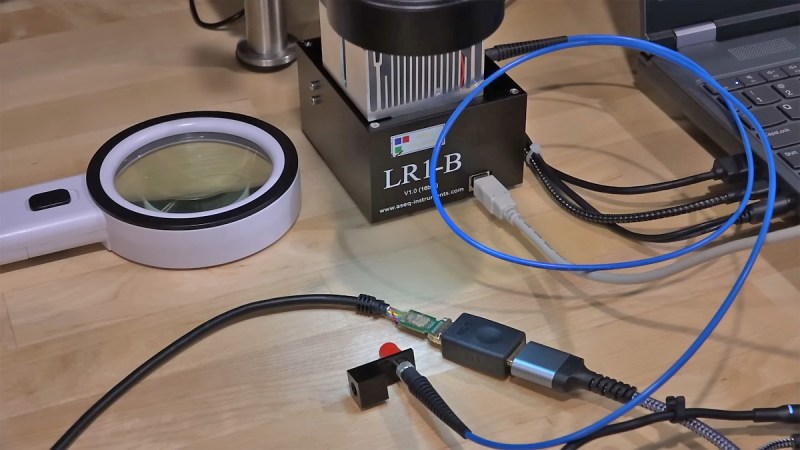In a recent video, [Shahriar] from The Signal Path has unveiled the intricate design and architecture of optical HDMI cables, offering a cost-effective solution to extend HDMI 2.0 connections beyond the limitations of traditional copper links. This exploration is particularly captivating for those passionate about innovative hardware hacks and signal transmission technologies.
[Shahriar] begins by dissecting the fundamentals of HDMI high-speed data transmission, focusing on the Transition Minimized Differential Signaling (TMDS) standard. He then transitions to the challenges of converting from twisted-pair copper to optical lanes, emphasizing the pivotal roles of Vertical-Cavity Surface-Emitting Lasers (VCSELs) and PIN photodiodes. These components are essential for transforming electrical signals into optical ones and vice versa, enabling data transmission over greater distances without significant signal degradation.
A standout aspect of this teardown is the detailed examination of the optical modules, highlighting the use of free-space optics and optical confinement techniques with lasers and detectors. [Shahriar] captures the eye diagram of the received high-speed lane and confirms the VCSELs’ optical wavelength at 850 nm. Additionally, he provides a microscopic inspection of the TX and RX chips, revealing the intricate VCSEL and photodetector arrays. His thorough analysis offers invaluable insights into the electronic architecture of optical HDMI cables, shedding light on the complexities of signal integrity and the innovative solutions employed to overcome them.
For enthusiasts eager to take a deeper look into the nuances of optical HDMI technology, [Shahriar]’s comprehensive teardown serves as an excellent resource. It not only gives an insight in the components and design choices involved, but also inspires further exploration into enhancing data transmission methods.
















Ah, cool, I saw one of these last week, and wondered what was in the cable. I thought it was pretty thick for just a single fiber, but figured they hardened it for the typical target environment.
I also wondered how they multiplexed the three signal lines, clock and other stuff down the fiber, and got data back from the display.
It didn’t occur to me to use multiple fibers and copper wires too, because a big reason to use fiber is to avoid the use of metallic conductors (For RFI out, EMI in, ground loops, lightning protection, etc).
All questions answered now, and I didn’t have to take apart the device. Good, because the owner would have been a bit pissed about it if I had.
[Shahriar] should make a print or wallpaper available of his shelves. Or even a downloadable image. I’d totally use it as a Zoom background.
If I remember in the early days of HDMI reading about it’s technical specs it was pointed out that it checks for cables that are too long and this was about preventing “theft” by sharing between apartments etc. not ensuring it’d work reliably. Hollywood Did Muck It. Scrambled content system gear on both ends of the cable.
HDMI cable length is entirely limited by signal integrity
So much engineering wasted on just watching a Marvel movie.
Years ago, no – decades ago, I was impressed by intel’s Light Peak.
And then it turned into lame Thunderbolt. Such an disappointment.
It’s really time for optical connections to become standard (provided, the fibres used aren’t carcinogenic).
Holding on to copper based technology such as DSL, 10BaseT and PCIe, Thunderbolt hinders progress.
Agree to disagree. As I said in the comments on Hackaday’s recent article about UTP Ethernet, 10/100/1000bT over Cat5/6e is a marvel. Astonishing, error-free transmission rates over distances of up to 500m without any sort of repeater or amplifier, and all in a cable package that can be fished through walls, wrapped around columns, and flung down air shafts without any degradation.
Optical fiber is great and certainly has its uses, but so does UTP. I wouldn’t want to try wiring my garage for data by flinging a single-mode optical line out the attic window of the main house, letting it drop two stories to the garage roof, stapling it in place, then shoving the end through a bore hole so it drops from the ceiling and can be punched down into an RJ45 jack..
(Yes, I meant 100m not 500m.)
I ran single mode throughout my house along with cat 6. It’s actually not any harder and supporting 10gb+ ethernet is more straight forward.
Very interesting teardown. Love the way he casually says “Only 5~6 GHz, so not that fast” when every peice of test equiptment I’ve ever owned begs to differ. I know state of the art has moved on significantly, but as a mere electronics hobbyist that assesment tickled me.
Ha, yeah, for hobby stuff I only have a 400MHz scope but it gets the job done for pretty much anything I care about.
Nicer VCSELs these days can do ~30GHz easy, so in the optics world, yeah, 6GHz is really slow.
At work we have keysight sampling scopes that have something like a 110GHz bandwidth. I have to keep reminding myself that those are a bit insane outside of our niche world…
40Gbit/s QSFP+ transceiver is cheap and it has 4 lanes in each direction.
Not terribly relevant though: That’s just one end of a cable, and doesn’t even include the cable. This complete HDMI solution with receiver, transmitter and cable is half the price of a single QSFP transceiver.
I thought hacking around w/ HDMI signals was illegal? Aren’t they like hyper-proprietary?
This product does not deal with the protocol at all.
Arggh. I mourn for our civilization if this is the default opinion of most people on technology. As if the handbasket wasn’t already enough off course.